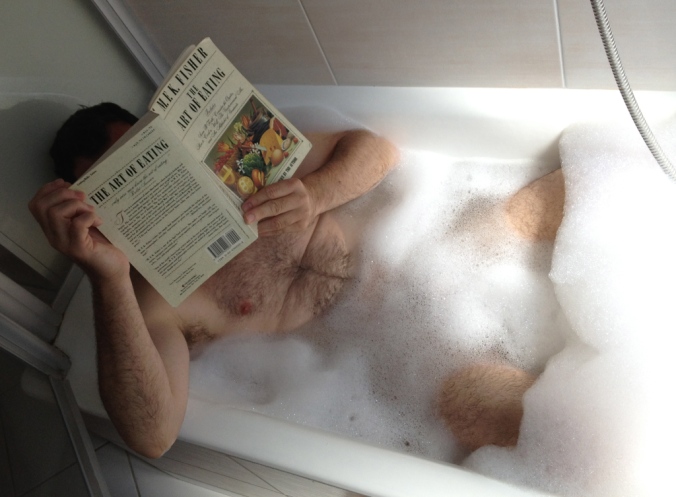(Editor’s note: A few readers have chastised me for neglecting to include a recipe in this post. That oversight has now been rectified. Please let me know how you make pasta, and if you have never made fresh pasta at home, I hope this post inspires you to do so.)
“I still think that one of the pleasantest of all emotions is to know that I, with my brain and my hands, have nourished my beloved few, that I have concocted a stew or a story, a rarity or a plain dish, to sustain them truly against the hunger of the world.”
– M.F.K. Fisher, The Gastronomical Me

It is simple, and the payoff is extremely satisfying.
Pasta from a box is fine. I use it, mostly penne and farfalle. But there is nothing better than fresh pasta, and I am always happy when I can show people how easy it is to make their own. I taught my 8-year-old nephew how to make pasta, and I’ve guided Angela through the process – she is now expert at it.
I have a stand mixer and pasta attachments, and love it, but that has not prevented me from making hundreds of batches of linguine and ravioli and other varieties of pasta by hand. And there is a bonus: It is a meditative process. The action of mixing and kneading and rolling and cutting calms one’s mind.
There are plenty of recipes and methods for making pasta. I use two eggs (sometimes three), some olive oil, and, of course, flour and water. Over the years I have discovered my own technique and method. (You will, too.) Here is mine, and I give all thanks to Lidia Bastianich, whose pasta I encountered firsthand at Felidia years ago. I followed her methods and have revised them as time has passed. (Marcella Hazan is another inspiration, for pasta and many other things. Get to know her.)
First, relax. Do not get uptight about the process. It is a simple thing, depending on the shape of pasta you wish to make. Put on some good music, open a bottle of wine. Choose a smooth and large working surface; if you have a work island, use it. (I use a large wooden butcher’s block.) Make sure the surface is clean and dry. Sift two cups all purpose flour onto the surface and form it into a mound. Make an indentation in the middle of the mound. In a small bowl, mix two eggs, 1/4 tablespoons extra virgin olive oil, and 3 tablespoons of water. (I often add a pinch of salt. You can as well.) Gently pour the liquid mixture into the flour’s crater, and, using a fork, combine the liquid and the solid. Then, with lightly floured hands, mix and knead the dough until it is soft and smooth. (You will get the hang of it after a few attempts. Again, it is not difficult. In all, it should take you about 8 minutes or so to make the dough.) If the dough is too moist, add a little flour. If too dry, add a touch of olive oil. As you make more and more pasta, your hands and eyes will guide you. You will know when it is correct.
Form the dough into a ball and wrap tightly in plastic wrap. If you are going to use it that evening, let it sit at room temperature for 30 minutes before rolling it out. (Wrapped tightly and well, you can freeze the dough; I have frozen it for as long as a month, but I rarely do this.)


He did this: Ian’s pasta.
When you are ready to roll, clean your work surface, get a rolling pin, and divide your ball into three pieces; lightly flour the surface – a dusting – and roll until the dough is as thin as you can make it. (In the photo below is a modified fettuccine, and we should have produced thinner noodles – they always expand in the water. But again, do not fret … on this evening we made basil pesto, and the meal was delicious, thick noodles and all.)
To make this simple ribbon pasta, use a sharp knife and cut the dough in straight lines, lightly arranging the ribbons into three bird’s nest clumps. Bring some salted water to a vigorous boil and, one bird’s nest at a time, cook the noodles until they float to the top of the water. (One important thing: Many home cooks err by not using a sufficient amount of water. Get your largest pot, and do not skimp on the water; the noodles need room in which to move and evenly cook.)
Have a sauté pan ready (with your desired sauce in it: oil and onions, tomatoes, pesto … your imagination is the limit). Lift the pasta from the water and add it to the pan, coating the ribbons thoroughly. (I also like to cook the pasta a bit longer in the pan, a minute or so; it makes everything taste better.)
That’s it. After you do this a few times, you’ll be ready for ravioli and orecchiette.

Flour and eggs and water and oil, plus you.
Like this:
Like Loading...













Recent Comments